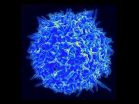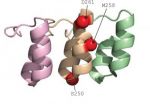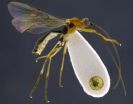(Press-News.org) May 8, 2014, Shenzhen, China – In a paper published in the May 8 issue of the journal Cell as the cover story, researches from BGI, University of California, University of Copenhagen and other institutes presented the first polar bear genome and their new findings about how polar bear successfully adapted to life in the high Arctic environment, and its demographic history throughout the history of its adaptation.
Polar bears are at the top of the food chain, and spend most of their lifetimes on the sea ice largely within the Arctic Circle. They were well known to the worldwide people for their white coat, big body size, thick layer of body fat and the ability of long distance swimming. However, the current living situation of polar bear is not that optimistic as people used to think. They have been facing the challenges and threats from the climate change in recently years, and the key danger posed by climate change is the unceasing lost habitats. Therefore, polar bear is always serving as an important indicator of climate change due to their dependence on sea ice in the Arctic.
The analysis in the study included blood and tissue samples from 79 Greenlandic polar bears and 10 brown bears from Sweden, Finland, Glacier National Park in Alaska and the Admiralty, Baranof, and Chichagof (ABC) Islands off the Alaskan coast.
The results reveal that the polar bear is a much younger species than previously believed, having diverged from brown bears less than 500,000 years ago, and also uncovered several genes that may be involved in the polar bears' extreme adaptations to life in the high Arctic.
The genes pinpointed by this study are related to fatty acid metabolism and cardiovascular function, and may explain the bear's ability to cope with a high-fat diet while avoiding fatty plaques in their arteries and the cardiovascular diseases that afflict humans with diets rich in fat. These genes may provide insight into how to protect humans from the ill effects of a high-fat diet.
"For polar bears, profound obesity is a benign state," said Eline Lorenzen, one of the lead authors of the study. "We wanted to understand how they are able to cope with that."
The genome analysis comes at a time when the polar bear population worldwide, estimated at between 20,000 and 25,000 individuals, is declining and its habitat, Arctic sea ice, is rapidly disappearing. As the northern latitudes warm, its distant cousin the brown or grizzly bear (Ursus arctos) is moving farther north and occasionally interbreeding with the polar bear (U. maritimus) to produce hybrids dubbed pizzlies.
"Their ability to interbreed is a result of this very close relationship", Rasmus Nielsen, one of the corresponding authors, said, "which is one-tenth the evolutionary distance between chimpanzees and humans." Previous estimates of the divergence time between polar bears and brown bears ranged from 600,000 to 5 million years ago.
"It's really surprising that the divergence time is so short. All the unique adaptations polar bears have to the Arctic environment must have evolved in a very short amount of time," he said. These adaptations include not only a change from brown to white fur and development of a sleeker body, but big physiological and metabolic changes as well. "There has been a lot of debate about it, but I think we really nailed down what the divergence time is between them, and it is surprisingly recent."
The genome comparison reveals that over several hundred thousand years, natural selection drove major changes in genes related to fat transport in the blood and fatty acid metabolism. One of the most strongly selected genes is APOB, which in mammals encodes the main protein in LDL (low density lipoprotein), known widely as "bad" cholesterol. Changes or mutations in this gene reflect the critical nature of fat in the polar bear diet and the animal's need to deal with high blood levels of glucose and triglycerides, in particular cholesterol, which would be dangerous in humans. Fat comprises up to half the weight of a polar bear.
"The life of a polar bear revolves around fat," Lorenzen added. "Nursing cubs rely on milk that can be up to 30 percent fat and adults eat primarily blubber of marine mammal prey. Polar bears have large fat deposits under their skin and, because they essentially live in a polar desert and don't have access to fresh water for most of the year, rely on metabolic water, which is a byproduct of the breakdown of fat."
She noted that the evolution of a new metabolism to deal with high dietary fat must have happened very quickly, in just a few hundred thousand years, because we know that polar bears already subsisted on a marine diet 100,000 years ago.
What drove the evolution of polar bears is unclear, though the split from brown bears (dated at 343,000–479,000 years ago) coincides with a particularly warm 50,000-year interglacial period known as Marine Isotope Stage 11. Environmental shifts following climate changes could have encouraged brown bears to extend their range much farther north. When the warm interlude ended and a glacial cold period set in, however, a pocket of brown bears may have become isolated and forced to adapt rapidly to new conditions.
"The next step will be to look back in time by sequencing genomes from ancient polar bears, to address the evolutionary mode and nature of these adaptations", said professor Eske Willerslev from Centre for GeoGenetics, University of Copenhagen.
"The evolution history of polar bear demonstrated how quickly an organism could adapt to the evolutionary challenges ", said Jun Wang, "This is one of the exciting animal genome projects that initiated by BGI. With genomic data released for more species, we hope to reveal a more complete picture of how animals adapt to environment and how biodiversity forms".
INFORMATION: END
Population genomics study provides insights into how polar bears adapt to the Arctic
The latest study was published in Cell as cover story
2014-05-08
ELSE PRESS RELEASES FROM THIS DATE:
How immune cells use steroids
2014-05-08
Hinxton, 8 May 2014 – Researchers at the European Bioinformatics Institute (EMBL-EBI) and the Wellcome Trust Sanger Institute have discovered that some immune cells turn themselves off by producing a steroid. The findings, published in Cell Reports, have implications for the study of cancers, autoimmune diseases and parasitic infections.
If you've ever used a steroid, for example cortisone cream on eczema, you'll have seen first-hand how efficient steroids are at suppressing the immune response. Normally, when your body senses that immune cells have finished their job, ...
Just keep your promises: Going above and beyond does not pay off
2014-05-08
May 8, 2014 - If you are sending Mother's Day flowers to your mom this weekend, chances are you opted for guaranteed delivery: the promise that they will arrive by a certain time. Should the flowers not arrive in time, you will likely feel betrayed by the sender for breaking their promise. But if they arrive earlier, you likely will be no happier than if they arrive on time, according to new research. The new work suggests that we place such a high premium on keeping a promise that exceeding it confers little or no additional benefit.
Whether we make them with a person ...
Universal neuromuscular training an inexpensive, effective way to reduce
2014-05-08
ROSEMENT, Ill.─As participation in high-demand sports such as basketball and soccer has increased over the past decade, so has the number of anterior cruciate ligament (ACL) injuries in teens and young adults. In a study appearing today in the Journal of Bone and Joint Surgery (JBJS) (a research summary was presented at the 2014 Annual Meeting of the American Academy of Orthopaedic Surgeons in March), researchers found that universal neuromuscular training for high school and college-age athletes—which focuses on the optimal way to bend, jump, land and pivot the knee—is ...
Collaboration between psychologists and physicians important to improving primary health care
2014-05-08
WASHINGTON - Primary care teams that include both psychologists and physicians would help address known barriers to improved primary health care, including missed diagnoses, a lack of attention to behavioral factors and limited patient access to needed care, according to health care experts writing in a special issue of American Psychologist, the flagship journal of the American Psychological Association.
"At the heart of the new primary care team is a partnership between a primary care clinician and a psychologist or other mental health professional. The team works together ...
Small mutation changes brain freeze to hot foot
2014-05-08
DURHAM, N.C. -- Ice cream lovers and hot tea drinkers with sensitive teeth could one day have a reason to celebrate a new finding from Duke University researchers. The scientists have found a very small change in a single protein that turns a cold-sensitive receptor into one that senses heat.
Understanding sensation and pain at this level could lead to more specific pain relievers that wouldn't affect the central nervous system, likely producing less severe side effects than existing medications, said Jörg Grandl, Ph.D., an assistant professor of neurobiology in Duke's ...
Statins given early decrease progression of kidney disease
2014-05-08
AURORA, Colo. (May 8, 2014) - Results from a study by University of Colorado School of Medicine researchers show that pravastatin, a medicine widely used for treatment of high cholesterol, also slows down the growth of kidney cysts in children and young adults with autosomal dominant polycystic kidney disease (ADPKD).
ADPKD is the most common potentially lethal hereditary kidney disease, affecting at least 1 in 1000 people. ADPKD is characterized by progressive kidney enlargement due to cyst growth, which results in loss of kidney function over time. At one time, ADPKD ...
Mummy-making wasps discovered in Ecuador
2014-05-08
Some Ecuadorian tribes were famous for making mummified shrunken heads from the remains of their conquered foes. Field work in the cloud forests of Ecuador by Professor Scott Shaw, University of Wyoming, Laramie, and colleagues, has resulted in the discovery of 24 new species of Aleiodes wasps that mummify caterpillars. The research by Eduardo Shimbori, Universidade Federal de São Carlos, Brazil, and Scott Shaw, was recently published in the open access journal ZooKeys.
Among the 24 new insect species described by Shimbori and Shaw, several were named after famous people ...
NASA sees system 91B lingering over southwestern India
2014-05-08
The tropical low pressure area known as System 91B has been making a slow northerly crawl while sitting inland in southwestern India, and NASA's Terra satellite captured a visible image of the struggling storm that showed half of it is over the Northern Indian Ocean.
NASA's Terra satellite passed over System 91B over southwestern India and the Moderate Resolution Imaging Spectroradiometer (MODIS) instrument captured a visible image on May 8 at 05:40 UTC/1:40 a.m. EDT. The despite having a poorly defined low-level circulation center on infrared imagery, the circulation ...
Experimental antibody shows early promise for treatment of childhood tumor
2014-05-08
Tumors shrank or disappeared and disease progression was temporarily halted in 15 children with advanced neuroblastoma enrolled in a safety study of an experimental antibody produced at St. Jude Children's Research Hospital. Four patients are still alive after more than two-and-a-half years and without additional treatment.
Findings from the Phase I study were published recently online and will appear in the May 10 edition of the Journal of Clinical Oncology. The results prompted St. Jude to expand clinical trials of the monoclonal antibody hu14.18K322A to include patients ...
Wake Forest Baptist finds success with novel lung cancer treatment
2014-05-08
WINSTON-SALEM, N.C. – May 8, 2014 – An old idea of retreating lung tumors with radiation is new again, especially with the technological advances seen in radiation oncology over the last decade.
The Comprehensive Cancer Center of Wake Forest Baptist Medical Center is one of only a handful of cancer centers that is attempting to give lung cancer patients out of treatment options a chance to keep the cancer at bay. For these patients, hope lies in a second course of treatment – repeat radiation. Two complementary papers published back-to-back recently in the journal Radiotherapy ...
LAST 30 PRESS RELEASES:
Why are there so many Nordic mediators?
Young shark species more vulnerable to extinction
Mobile fetal heart monitoring linked to fewer newborn deaths in Tanzania
Bluey’s dad offered professorial chair in archaeology at Griffith University
Beyond small data limitations: Transfer learning-enabled framework for predicting mechanical properties of aluminum matrix composites
Unveiling non-thermal catalytic origin of direct current-promoted catalysis for energy-efficient transformation of greenhouse gases to valuable chemicals
Chronic breathlessness emerging as a hidden strain on hospitals
Paleontologists find first fossil bee nests made inside fossil bones
These fossils were the perfect home for ancient baby bees
Not everyone reads the room the same. A new study examines why.
New research identifies linked energy, immune and vascular changes in ME/CFS
Concurrent frailty + depression likely boost dementia risk in older people
Living in substandard housing linked to kids’ missed schooling and poor grades
Little awareness of medical + psychological complexities of steroid cream withdrawal
Eight in 10 trusts caring for emergency department patients in corridors, finds BMJ investigation
NASA’s Webb telescope finds bizarre atmosphere on a lemon-shaped exoplanet
The gut bacteria that put the brakes on weight gain in mice
Exploring how patients feel about AI transcription
Category ‘6’ tropical cyclone hot spots are growing
Video: Drivers struggle to multitask when using dashboard touch screens, study finds
SLU research shows surge in alcohol-related liver disease driving ‘deaths of despair’
Rising heat reshapes how microbes break down microplastics, new review finds
Roots reveal a hidden carbon pathway in maize plants
Membrane magic: FAMU-FSU researchers repurpose fuel cells membranes for new applications
UN Member States pledge to increase access to diagnosis and inhaled medicines for the 480 million people living with COPD
Combination therapy shows potential to treat pediatric brain cancer ATRT
Study links seabird nesting to shark turf wars in Hawai‘i
Legal sports betting linked to sharp increases in violent crime, study finds
Breakthrough AI from NYUAD speeds up discovery of life-supporting microbes
New Eva Mayr-Stihl Foundation funding initiative boosts research at University of Freiburg on adaptation of forests to global change
[Press-News.org] Population genomics study provides insights into how polar bears adapt to the ArcticThe latest study was published in Cell as cover story



